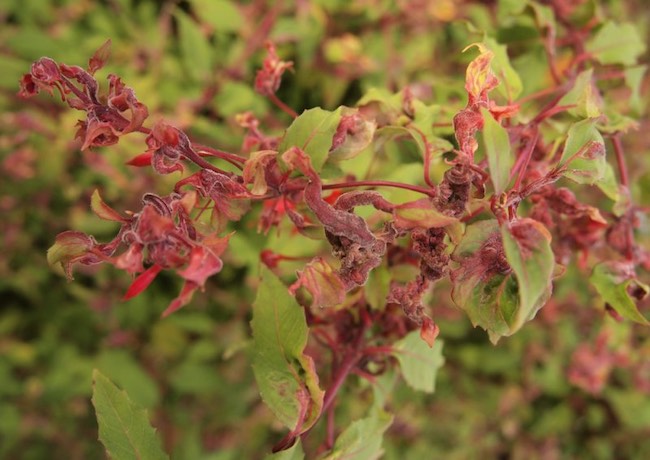How to deal with Fuchsia Gall Mites

Fuchsia gall mite was found in mainland Britain in 2007. It has become a frequent enquiry to the GardenAdvice Gardening Advice service, especially from southern England. It has also spread northwards and into Wales.
The main symptoms are growth at the shoot tips is swollen and distorted, often with a yellowish green or reddish discolouration. Flowers are deformed or fail to develop
Fuchsia gall mite is a microscopic sap-sucking mite that is specific to fuchsias. It can
cause extensive galling and distortion affecting the appearance of fuchsias.
Gall mites are tiny sap-sucking creatures that can cause a variety of abnormal growths on various plants. Although too small to be seen without a microscope, the galled tissues that they create are often very distinctive and easily recognised. Most gall mites are harmless and are part of the biodiversity a healthy garden can support.
Control of Fuchsia Gall Mites
Non-pesticide control
- The mite will not kill fuchsias but does affect growth and appearance
- Cutting off affected shoot tips will remove many mites but regrowth is likely to become re-infested. Affected material can be disposed of in council waste or buried to reduce likelihood of spreading the mite
- In California, it has been noted that although all fuchsias can host the mite, species and cultivars vary in susceptibility. The most susceptible species include Fuchsia arborescens, F. magellanica and F. procumbens
- A predatory mite (Amblyseius andersoni) is sold a biological control of the mite
Control with Synthetic insecticides: contact action
Synthetic pyrethroids
Contact and broad spectrum, effective against a wide range of insects including aphids, whiteflies, leafhoppers, thrips, beetles, ants and small caterpillars. By making alterations to the molecular structure of natural pyrethrum, synthetic photostable pyrethroid compounds, such as cypermethrin, lambda- cyhalothrin deltamethrin and permethrin, were developed. These synthetic pyrethroids retain the low mammalian toxicity of other pyrethroids but can remain active against insects for several weeks. Natural pyrethroids break down quickly in sunlight losing their activity within days. Some products can be used on listed food plants.
a) Deltamethrin
A spray concentrate and ready to use for controlling aphids, whitefly, caterpillars, codling moth, plum moth, tortrix moths, raspberry beetle, flea beetles, weevils, sawfly larvae, apple and pear suckers, leafhoppers, capsid bugs, scale insects and mealybugs on ornamental plants and a wide range of listed edibles.
Sprays
Baby Bio Houseplant Bug Killer RTU
Provanto Ultimate Bug Killer RTU and concentrate
Provanto Ultimate Fruit & Vegetable Bug Killer RTU and concentrate Provanto Sprayday Greenfly Killer concentrate
Toprose Bug Killer RTU
b) Lambda-cyhalothrin
A concentrate and ready to use spray for controlling aphids, capsid bug, thrips, whitefly, beetles, caterpillars, pea moth, pea and bean weevil, sawflies, leaf curling midges, carrot fly adults and some other insects. Can be used on ornamental plants and a wide range of listed fruits and vegetables.
Sprays Westland Resolva Bug Killer RTU and concentrate





















